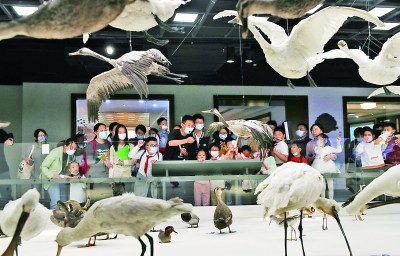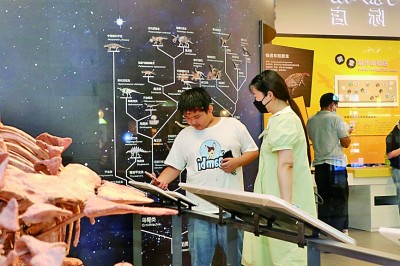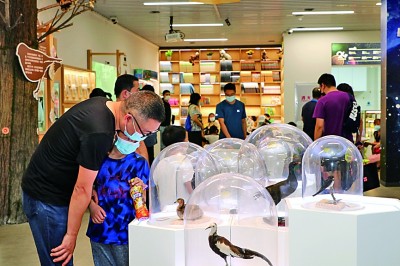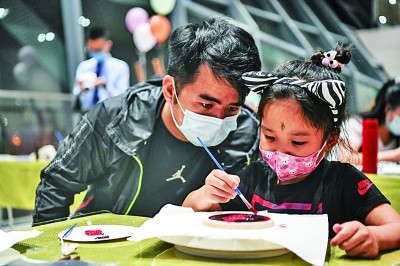
On May 18, 2021, the audience participated in the "Fantastic Night" series of activities at the Shanghai Museum of Nature. Xinhua news agency

The audience visited the 24-hour museum of Zhejiang Natural Museum. Photo by Zhang Zhenzhen/Bright Picture

The audience visited the 24-hour museum of Zhejiang Natural Museum. Photo by Zhang Zhenzhen/Bright Picture

In Chengdu Museum, parents take their children to experience the making of lacquerware in Chengdu at night. Xinhua news agency
When night falls and the lights are on, can the tired city dwellers find a quiet leisure place and fully enjoy the cultural nourishment, in addition to the lively entertainment and consumption places such as cinemas, bars and KTV? A museum that opens at night may be a very good choice. Regrettably, although museums all over the country have tried to delay opening in recent years, holding night cruises, staying in museums and other activities, museums that normalize "opening at night" are still scarce.
In Hangzhou, Zhejiang Province, the "24-hour Museum of Zhejiang Natural Museum" has experienced more than 20,000 visitors since it was put into trial operation for more than a month. After entering the summer vacation, the number has continued to climb. The venue is a 300-square-meter small cultural space built by Zhejiang Natural Museum. Its business hours are from 10 am to 24 midnight from Monday to Friday, and it is open 24 hours a day on Saturday and Sunday. This great breakthrough is the first in a state-owned museum. Taking this as a signal, can we expect that "latecomers" may emerge one after another, making museums one of the main venues of urban nightlife?
1. The audience needs to pull the museum to keep trying.
Recently, the Changjiang Daily’s continuous report on a "citizen’s suggestion" became a beautiful talk: in late June, Mr. Kang, a citizen of Wuhan, made a suggestion on the message board of Wuhan City. Since the summer, more and more people have visited Hankou River Beach at night, hoping that the Museum of Crossing the Yangtze River next to Yuehan Wharf can be opened at night, adding cultural flavor to the night tour of the river beach. On July 6th, Wuhan Jiangtan Office responded to this suggestion and announced that the opening hours of the Yangtze River Crossing Museum would be adjusted from 12: 30 to 20: 30 every Friday and Saturday from July 8th to August 31st. According to reports, on the day of the opening of the night tour on July 8, the total passenger flow of the museum was 316. Among them, the passenger flow after 16: 30 (the previous closing time) was 146, which was more than doubled compared with the previous data of the same period.
Equally popular is the 24-hour Museum of Zhejiang Natural Museum, which is located in the center of Hangzhou and has convenient transportation. "In the past, we often received calls from tourists. During the day, we were busy visiting the West Lake and enjoying the beautiful scenery. At night, we wanted to take our children to visit the museum. But most museums are ‘ Nine to five ’ Open, it is difficult to meet everyone’s needs for cultural life. " Yan Hongming, president of Zhejiang Natural Museum, said that the idea of opening a "night museum" came into being as early as 2014. It happened that the museum recently recovered a 310-square-meter facade room along the street, which was suitable for creating a separate cultural new space, and began the preparations for the 24-hour museum.
On the first day of trial operation, the 24-hour Museum of Zhejiang Natural Museum received more than 700 tourists in 9 hours from 15: 00 to 24: 00. According to the staff, almost every day from 10: 30 to 21: 30 is the peak time because it coincides with the summer vacation. In order to ensure the quality of the exhibition, the venue had to limit the flow to 100 people per hour, and many spectators waited in line outside the door. In order to "miss the peak", some viewers choose to go early in the morning or two or three in the morning on weekends. A citizen left a message after the exhibition: "After the opening of the 24-hour museum, we have another place to visit, which can not only cool off in the summer, but also learn a lot of interesting knowledge of nature."
In the summer vacation, the 24-hour museum of Zhejiang Natural Museum is "one ticket is hard to find". According to the weekly data, during the week from July 4th to 10th, the museum received an average of 940 people every day. From 16: 00 to 22: 00, three or four hundred people enter the museum every day; From 22: 00 to 24: 00, although there were no more than 50 people on weekdays, it soared to nearly 200 people on weekends.
"The night at the museum is very special because it has a quiet and visual feeling different from that during the day. This special experience is very attractive to the public. " Chen Lvsheng, former deputy director of the National Museum of China, wrote in the book The Beauty of Museums. He believes that it is very important for the city and the public to extend the opening of the museum to the evening as a normal state. The museum opens at night, regardless of the length of time, which reflects the civilization level and citizen quality of the city where it is located.
In fact, before the outbreak, in order to promote the prosperity of the night economy, the cultural and tourism departments of some cities planned and organized the "collective action" of museums, which was linked to the night tourist routes of the cities. In August, 2019, Guangzhou Cultural Tourism Bureau organized eight exhibition halls, including Guangzhou Museum and Sun Yat-sen Marshal’s Mansion Memorial Hall, to open at night, that is, it was delayed until 21: 00 every Friday, Saturday and Sunday, and the explanation service was basically the same as that during the day. The Shanghai Cultural Tourism Bureau piloted the normal night tour project of museums for the first time from July to September 2019, and selected 14 pilot museums to extend their opening on Friday night; From June to August, 2021, the number of participating museums expanded to 30, providing citizens and tourists with a rich choice of night tours. Unfortunately, under the influence of the epidemic, the cultural tourism industry is inevitably impacted, and this linkage form of "museum fever" is still gradually recovering.
On July 12, 2022, the Beijing Municipal Bureau of Culture and Tourism issued a notice that the museums in Beijing will carry out activities such as delayed opening to light up the "night capital" in summer. According to the conditions in the museum, museums will also extend their opening hours in due course, carry out evening cultural activities, or make appropriate arrangements for evening receptions based on planned activities. The museum is becoming a new landmark of people’s nightlife, opening a wonderful "museum night" for the audience in the hot summer.
2. Diversified museum space makes the audience linger.
"Giving priority to scientific and educational activities, supplemented by explanations" is the basic orientation of the 24-hour museum of Zhejiang Natural Museum. Perhaps it is this positioning that has made it gather a lot of popularity in the trial operation for more than a month. Hong Lei, a science and education staff member of Zhejiang Natural Museum, told the reporter that in summer, the 24-hour museum will hold several popular science education activities for young people including fossil excavation and volcanic science experiments, and the weekend night show is "locked in early" by many parents and children.
In order to make the audience of all ages have a pleasant exhibition experience, in this small world of 300 square meters, interactive equipment can be seen everywhere: press the button below the bird specimen, and you can hear its unique singing; Spend 10 yuan’s money on materials. After coloring the fish stick figure, scan it with AR device, and fish will swim lightly on the projection curtain. There is also an interesting device of "I am taller than dinosaurs", and the Meta-Universe Theater can order popular science movies and watch online exhibitions. Tired of watching, the audience can also order a cup of coffee in the reading area, or taste the limited ice cream and dessert in the 24-hour museum. It can be said that "the sparrow is small and complete".
"Now the development direction of museums, especially the development direction of popular science education and exhibitions, is very different from the traditional museums in the original sense." Hong Lei said that before entering the museum, it was to "see" the exhibition, and the specimens were placed in the showcase of the window. Now, after a series of reforms, there are diversified forms such as scene simulation, interactive exhibits and multimedia on the display, combined with the living specimen showcase, which brings a different experience to the audience.
During the tour, Hong Lei paid attention to the different interests of audiences of different ages: children like dinosaurs named after Zhejiang land, such as Yang Yandong Yang Dunlong, Lixian Jiangshan Dragon and Lishui Zhejiang Dragon; Young and middle-aged audiences will be more attracted to rocks and minerals and native birds and insects; The elderly audience will prefer to study Chinese herbal medicines and grains. "Taking the animals, plants and minerals around us as the theme is because everyone can come into contact with it at ordinary times, but they don’t understand it. Excavating the knowledge around you can inspire the interest of the audience. " Hong Lei said.
If "24 hours" is to let more tourists come to the museum through the extension of time, then when the visit is coming to an end, purchasing the museum’s "tailor-made" cultural and creative products is to let the museum integrate into people’s daily lives again. During the trial operation, the 24-hour museum customized butterfly and beetle crystal specimens and the 24-hour museum logo ice cream have met with the audience. Next, the museum will also develop a number of cultural and creative product systems including meteorites and space series.
It is true that people expect museums to be integrated into the city’s leisure lifestyle at night, so that more cultural resources can be more convenient to get close to. However, if the delayed opening only delays the opening of a huge exhibition hall, it will burden the museum’s manpower and funds, but it will waste resources. Therefore, to make the museum "more exciting at night" is inseparable from the museum’s "crossing the river by feeling the stones" in light of its own actual situation, and it is also inseparable from the support of relevant departments and all walks of life.
3. Opening at night is "not simple" and faces many challenges.
"The quality of exhibitions and activities determines the attraction of the night show, and the audience will not come if the door is open." Chen Ceng Lu, director of the Wu Culture Museum, once said in an interview that the evening performances should not only be simple and open, but should be organically combined with educational activities, so that everyone can enjoy it at this time differently from the daytime.
When it comes to the night activities of the museum, we have to mention the Lantern Festival held by the Palace Museum in 2019. At that time, it became a hot topic because "one ticket is hard to find". The news that "the traffic of grabbing tickets is too large, which leads to the instant collapse of the website server" and "the scalper ticket is up to 9999 yuan" is staggering. The reason is that, in addition to holidays, "scarcity" is the key — — The stunt of "The Palace Museum is open to the public at night for the first time in 94 years" can’t help but make people greedy.
As a result, discussions have been launched on social platforms: Why can’t night activities be launched regularly, so that more people have the opportunity to participate? Some experts have analyzed that increasing lighting facilities and laying a large number of wires will increase the security risks in the Forbidden City, and ancient buildings with wooden structures cannot afford this risk; Not to mention the difficulty of managing tourists at night, there are still some cultural relics that are not suitable for night exhibitions and need timely rest.
In fact, it is not only the Forbidden City, but also the museums at all levels in China, which are facing a lot of challenges to normalize the opening at night. Chen Lvsheng believes that it is a great test to create more night shows, because it not only prolongs the working hours of staff, but also faces security problems and increased management costs caused by prolonged opening. Therefore, museums need greater economic investment to maintain their opening at night.
The Mumu Art Museum (Hall 798), located in Chaoyang District, Beijing, tried to extend its opening hours to 21 o’clock, and at the same time, it was accompanied by night activities such as immersive art healing, concerts and impromptu comedy experiences. "The Art Museum is in the 798 Art Zone, and the passenger flow is obvious ‘ Tide ’ Phenomenon, suitable for extending opening hours on weekends and holidays. At the same time, according to the user survey results, simply extending the opening hours can not significantly promote the audience to see the exhibition, but needs to give the audience an attractive reason. " Han Lin, the founder, said that he would not try to open the museum 24 hours at present, but should make a comprehensive evaluation based on the epidemic prevention policy and the management requirements of the park where the art museum is located, combined with the needs of the audience of the art museum.
Due to the shortage of manpower, the 24-hour museum of Zhejiang Natural Museum openly recruited supernumerary scientific and educational personnel for the society in early July. According to Yan Hongming, the entire operation and management team of the 24-hour museum consists of nine full-time staff, and two part-time staff were added in the summer. At the same time, the museum also set up a special class for 19 people, including the collection group, the education group, the management group and the security group, to ensure that "the wonderful does not fight".
At the same time, the challenge of keeping pace with the basic operation, publicity and promotion, human resources management and other costs is whether the museum can provide content and experience that "complement each other" with 24 hours. Which high-quality cultural products to choose to support the night show not only tests the museum’s professional level, but also reflects the museum’s aesthetic vision and artistic ability.
In recent years, natural history experts often emphasize "locality", that is, telling local stories well, with the aim of letting more people deepen their understanding of the local area and understand the natural environment around them. And the interest in the animals and plants around us is the beginning of ecological protection consciousness.
If the 9000-square-meter permanent exhibition hall of Hangzhou Pavilion of Zhejiang Natural Museum tells a "grand narrative" from the outbreak of life to the birth of human beings, then the 24-hour museum is an interest camp. More than 300 specimens displayed here are carefully selected from 270,000 collections, all of which are animals, plants and minerals in Zhejiang, and it is planned to update some exhibits from the massive collections every quarter.
"It is the responsibility and responsibility of our museum people to innovate exhibitions, promote the activation and utilization of collections, protect, inherit and display the outstanding achievements of Chinese civilization." Yan Hongming said that the Zhejiang Museum of Natural History had mobilized the participation and enthusiasm of potential audiences through crowdfunding, crowdsourcing and mass creation. The opening of the 24-hour museum this time is a new attempt to expand all over the country. While using the living museum collections and venue resources, we will focus on the "double reduction" of service and education to help "double promotion" and practice the contemporary mission of "a museum is a big school".
(Reporter Tang Yige Zhang Yun Lu Jian)